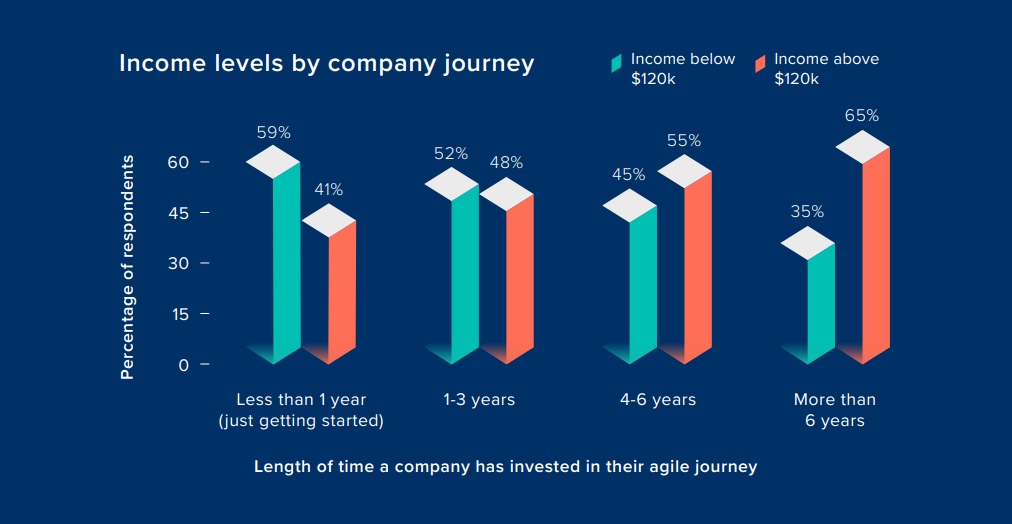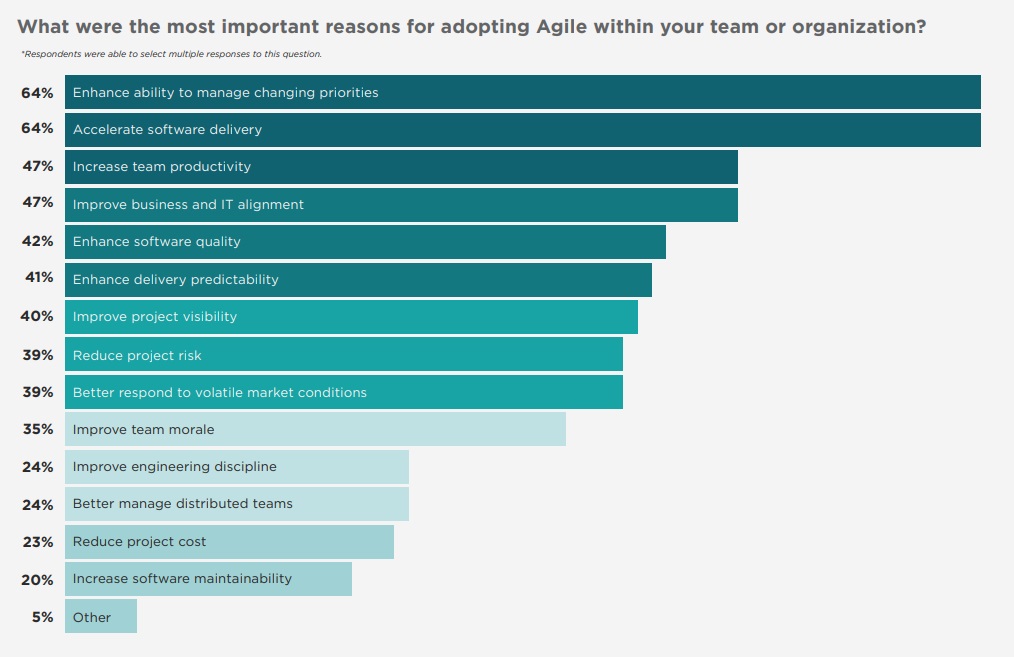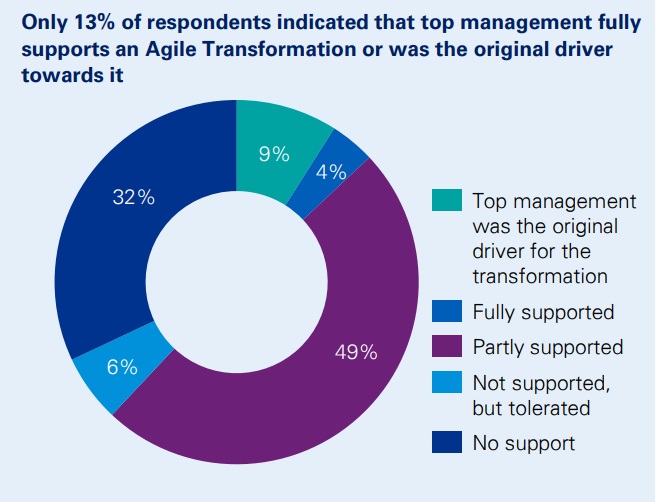Quick Summary :- Agile frameworks have significantly shaped the future of project management and IT organizations. Today, agile methodology has become widespread across various sectors, prompting us to discuss its current trends and transforming insights. Here, we will talk about 60+ agile statistics that are a must for you to know in 2025.
Today, Agile has revolutionized the world of software. In the year 2025, Agile will continue to dominate organizational approaches, promoting creativity and effectiveness. Notably, agile adoption among developers has soared from 37% to 86% in the last 5 years. Isn’t it quite an impressive figure?
Now the agile approach is spreading across industries to increase productivity and inspire innovation. This opens the door to the very subtle world of flexibility and adaptability, which is a combination of iterative cycles, customer-centricity, and also cross-functional collaboration.
So, you want to learn more about the agile statistics that will impact the organization of your work in the coming times? Then this blog is just for you, helping you understand agility.
The Agile Landscape: Insights into Skills and Education Trends
Let’s discover the agile adoption statistics and trends that define the skillsets and educational agendas in the agile domain. This will give you a glimpse into the new developments in project management and organizational agility.
1) According to a report, 50% of the agile coaches’ salaries are between $120K and USD 300K.
This shows the variable yet very profitable environment for professionals in the agile coaching field. This demonstrates the great need for their services and the important role they play in guiding organizations through successful implementations of Agile.
2) Only 17% of people agreed in the survey that their performance management systems helped achieve the flexible and collaborative goals of Agile.
This suggests a major disconnect between the incorporation of performance assessment practices and the tenets and workings of Agile methods in organizational systems.
3) 65% of coaching staff working for organizations with 6+ years of agile experience under their belt earn salaries north of $120,000.
This statistic highlights the increasing need for skilled Agile coaches and also the recognition of their great value through competitive salaries in the dynamic environment of Agile transformations.
4) Agile coaches stated that the biggest challenges in remote work are leadership, resistance to change, structures, culture, or mindset, and a lack of understanding of agile and remote working.
5) 22% of agile coaches indicate that they spend more than 21 hours a month on professional development.
This highlights the willingness of the Agile coaching community to keep up with the ever-changing methodologies and best practices, which shows how dynamic the field of coaching and leadership is and how they are constantly striving for perfection.
6) 44% of the certified Scrum Masters earned more than USD 100,000, while only 18% of those were uncertified.
Certification is a very important factor in determining the Scrum Masters’ compensation. This data highlights the practical effects that formal certification has on the pay scales for Scrum Master positions.
Agile Reshaping Marketing: A Closer Look at Current Agile Statistics
Agile is originally one of the software development methodologies, have made their way into the marketing field. It is transforming marketing strategies, increasing adaptability, and improving productivity.
7) Sprint or iteration review is another essential Agile practice, used by 45% of teams.
This statistic shows how widely structured iterative reviews are implemented, indicating continuous improvement and Agile principles of inspecting and adapting strategies to improve marketing results.
8) Kanban is the chosen methodology for 9% of the marketing teams.
This implementation reveals the adaptability and ease of Kanban, which allows the marketing teams to adopt a useful method to organize the tasks and improve the efficiency of their processes to achieve better results.
9) Most of the marketing teams (54%) opt for a hybrid approach.
This strategic decision indicates an awareness of the changing consumer environment in the industry and also the need to combine traditional and digital marketing approaches to create all-round and effective campaigns.
10) Standup meetings are the norm for 57% of the marketing teams.
This prevalence emphasizes the dedication to regular communication, transparency, and timely decision-making in teams. Daily standups promote interdependence, helping the teams remain more cooperative and agile in response to the shifting nature of the marketing environment.
11) 19% of teams prefer Scrum.
This choice reflects the flexibility and effectiveness that Scrum provides for team collaboration and delivery, making it a unique option among the wide range of agile methods.
12) 43% of the marketing departments identify insufficient training or unawareness of agile practices as the major obstacle to company-wide agile adoption.
The importance of education and awareness is very much highlighted in this statistic, which implies the need for comprehensive training for the successful adoption of agile within marketing teams and organizations.
13) The marketing teams use different Agile techniques and practices in their work. The most widely used practice is sprint or iteration planning, which is used by 58% of the teams.
Agile Mastery: Unveiling the Nexus Between Practices and Performance
Agile practices have a very significant influence on the performance of teams and also on overall organizational success.
14) Nearly 65% of the teams choose two-week sprints, which allows them to maintain a short but efficient agile cycle.
15) Teams that meet for the sprint with a regular cadence are 24% more responsive and 42% more consistent in the quality of their deliverables.
16) Effective retrospective-led teams have a 20% higher balanced performance than teams that do not conduct retrospectives.
17) Teams that focus more on controlling their work at each step cut the time it takes in half and have 75% fewer mistakes.
18) Teams that fully implement the Scrum method have higher quality than the teams that do not perform estimating.
This emphasizes the significant benefits of meticulous work management in enhancing efficiency and overall quality in team processes.
The Agile Wave: Unveiling Its Popularity and Pervasiveness
19) The Fortune 500 companies prefer it a lot.
This widespread acceptance highlights the acknowledgment of Agile’s effectiveness in improving flexibility, teamwork, and responsiveness, which aligns with the strategic goals.
20) Agile is FBI-approved.
After two failed attempts at agile project management and implementation, the FBI was finally successful after moving to an agile approach. That certainly tells us a lot about its likely efficacy and the size at which the year 2025 will see it rise a lot!
21) There are about 422 companies that are using agile project management tools.
This figure reflects the common use of specific tools that are aimed at improving the collaboration, efficiency, and flexibility of project management structures.
22) According to Deloitte Report 2017, Agile is used in about 80% of federal IT projects. This statistic reflects a significant shift towards agile practices within the federal sector.
23) Only 27.4% of manufacturers rely exclusively on the agile approach.
This figure illustrates the increasing importance of Agile methodologies in improving manufacturing operations, increasing agility, and ensuring effectiveness. Agile principles are adopted in this sector as a very strategic adaptation to the changing needs and the dynamic nature of the manufacturing industry.
Agile in Action: Exploring Adoption and Usage Agile Statistics
The adoption of Agile methodologies is on the rise, with software teams reaching 86%.
24) 16% of HR departments implement Agile in their workflows.
25) 86% of the teams have adopted the Agile approach. After that, 63% of the IT teams are also adopting agile approaches.
26) 81% of Agile teams use Scrum, including many variations such as Scrumban or a hybrid Scrum model.
27) The most widely used framework is the Scaled Agile Framework, with 37% of organizations using it.
28) The least popular Agile methodologies include Extreme Programming and Lean, with only 1% of the teams using each.
29) Marketing and security departments are also moving toward Agile, each at a 17% adoption rate.
30) Even in operations, Agile has left its mark with a 29% adoption rate.
31) Scrum of Scrum is the second-most popular framework for scaling Agile, used by 9% of organizations. Enterprise Scrum is also becoming very popular, with 6% of organizations adopting it.
Agile Statistics 2025: Insights on Navigating Trends and Numbers
32) 94% of organizations have been practicing Agile for about 1–5 years, and 33% have already been practicing for the last 3-5 years.
33) 64% of the companies using Agile Software Development Lifecycle for custom software development improved their ability to handle changing priorities effectively.
34) The adoption of Agile resulted in a 47% improvement in team productivity with the efficient delivery of the results.
35) The agile approach delivered 40% better project visibility across the departments of the surveyed firms.
36) Sixty-one percent of the companies use agile to achieve both software development and company-wide digital transformation.
37) The success rate of agile remains at the 80th percentile, compared to the other models.
38) The agile method helped 60% of the companies achieve increased revenue and profits.
39) 42 percent of the respondents who adopted agile practices reported a significant improvement in the software product development quality.
40) 47% of the organizations that implemented Agile reported that there was better communication and collaboration between the IT and business teams.
Agile Mastery in IT: Statistical Insights for 2025
41) These figures demonstrate that IT is the core of agile. This department manages the agile initiatives within the organizations and supplies the tools that support the agile practices.
It stands out as the epicenter of Agile adoption, usually leading the way in terms of initiatives and also managing the tools that support Agile practices. It is because of this central role that IT is viewed as a very critical element in the development of organizational agility, showing its power not only in the field of technology but also in shaping the overall agile transformations in different industries.
42) The most common leaders of agile transformations are 61% of executive management, 48% of Scrum Masters, and nearly 27% of IT managers.
The majority of Agile transformations are led by executive management, followed by scrum masters and IT managers. This distribution of leadership roles indicates the cross-functional nature of Agile initiatives, where the executives, scrum masters, and IT managers steer the organizations through the transformative changes based on Agile methodologies.
43) 80 percent of the U.S. federal IT projects were labeled as agile or iterative in 2017, compared to just 10 percent in 2011. This information illustrates the prevalence of Agile in the federal IT environment of the U.S.
44) 64% of the teams identify the key reason for implementing Agile as improving their ability to handle changing priorities and speeding up delivery by effectively leveraging the software development metrics. This figure highlights two of the core Agile principles of adaptability and agility that play a central role in responding effectively to changing project needs and speeding up delivery cycles.
Agile at the Helm: Exploring Leadership Trends and Numbers
45) In a KPMG survey, only 13% of the respondents reported that the top management fully supports the agile transformation.
This finding underscores a recurring barrier to gaining broad organizational support, underscoring the need for greater executive support to facilitate effective Agile initiatives and cultural changes within the surveyed organizations.
46) According to 72% of the respondents from the senior leadership team, the leaders in the organization were using agile ways of working successfully.
The perception of the senior leadership to this extent signifies a very positive congruence with the Agile practices, implying a leadership-level commitment to the Agile methodologies within the surveyed organizations.
47) In the same survey by KPMG, 62% of the top management showed a view that agile has no implications for them.
This perception reveals a possible knowledge or engagement gap, which highlights the need to create awareness and alignment on the executive level to ensure proper Agile implementation throughout the organization.
48) 38% of respondents in a KPMG survey stated that their agile transformation has no support from top management.
This statistic highlights a critical challenge. Emphasizing the need for increased leadership backing to overcome hurdles and foster a more conducive environment for successful Agile transformations.
Agile Realities: Challenges in Implementation
This exploration delves into the intricate landscape of Agile methodologies, exposing the hurdles faced during adoption. Uncover insights into the realities of implementation, shedding light on the intricate dynamics that organizations navigate as they strive to embrace and optimize Agile practices.
49) Almost half of the organizations adopting Agile have cultural mismatch issues.
Cultural fit is a very serious challenge that almost half of the organizations dealing with Agile methods have to address. Harmonizing values, beliefs, and practices through the adoption of Agile principles is indeed a very daunting task that reveals cultural transformation as a central element for the successful shift towards more efficient performance.
50) 35% of the people mention that skills gaps impede Agile adoption.
This figure demonstrates the necessity of funding training and development programs to prepare teams with the required knowledge to conduct Agile practices more effortlessly.
51) Even though Agile depends on teamwork, 42% of people find it challenging. Breaking down silos and ensuring constant communication are still problems that need attention.
Considering Agile Adoption in 2025? Stay Informed on Potential Pitfalls
52) 47% of Agile transformations fail.
Also, a critical Terminal factor contributing to 67% of Agile transformation failures lies in inconsistencies between adopted practices and processes. The disparity between envisioned Agile frameworks and the actual implementation within organizations often results in operational misalignments.
53) 74% attribute agile transformation failures to a lack of organizational support.
This points to a critical gap in fostering an agile-friendly environment, with potential hindrances stemming from resistance at various organizational levels.
Agile in the Spotlight: Current Conversations on Implementation in Organizations
Agile implementation refers to the adoption of a dynamic project plan where the development of small project elements is done one at a time.
54) 31% of the agile adopters use it incompletely initially.
55) Of the Agile users, 28% had a third party who had sponsored the adoption.
56) 20 percent of the people who used agile after the top level implemented agile practices.
57) Agile marketers claim to implement hybrid agile techniques in 61% of the many cases.
58) Agile enabled 98% of businesses to thrive, and you can also build your business to thrive in 2024 with Agile.
Unlocking Agility: A Call to Achieve Agile Transformation in 2025
59) The CAGR of the global enterprise agile transformation services market is anticipated to reach $142 by the end of 2032.
Global enterprise agile transformation services are estimated to record an outstanding CAGR of 19.50% by the end of 2026. This rapid development is an indicator of the increasing need for agile methodologies to improve organizational agility and efficiency in different fields worldwide.
60) The top management agile transformation goal for 83% of the companies is to have quick delivery to the customers.
This statistic highlights the strategic consideration of responsiveness, speed, and customer satisfaction as key goals in the restructuring of organizational structures and processes toward adopting agile methodologies.
61) 52% of respondents who follow the agile transformation model stated that they felt very empowered by their leaders.
This figure reflects the importance of leadership in creating an atmosphere that empowers the people, which is one of the key factors in successful agile transformations in organizations.
62) A culture of agility within your company will translate to a 237% increase in commercial performance. Keep this in mind when creating your agile culture in 2024.
Conclusion
In 2025, the agile landscape will be full of both promise and challenges. The Agile statistics show that it is still the dominant methodology, and there are substantial gains in productivity, customer satisfaction, and team empowerment. These numbers do not stand only for a methodology but for a transformative force defining how the teams work, innovate, and also deliver value. Therefore, organizations must move forward after knowing the agile adoption statistics that welcome change, agility, and the unrelenting drive for perfection.
So, do you need any assistance for implementing use Agile Practices in your organization? Connect with us Today!

















